
Thief Gamescom 2013 In-Depth Preview
For a series that focuses on the art of the steal, the Thief games have had plenty of ideas lifted from them for use in rival games. Most recently Dishonored “borrowed” plenty of ideas and stylistic elements from Garrett and his quick-fingered ways and comparisons to Arkane Software’s title are unavoidable. However, our recent time with Eidos Montreal’s reboot, simply titled Thief, seemed to provide a much richer, detailed gameplay experience.
Fresh from the success of Deus Ex: Human Revolution, the developers have chosen to completely reinvent the series rather than create a sequel or prequel. The team at Eidos Montreal were keen to retain the atmosphere of the classic Thief experience, but add a new, modern twist to the formula. Garrett, the master thief protagonist, remains the focus of the game’s story but there have been several changes to the gameplay.
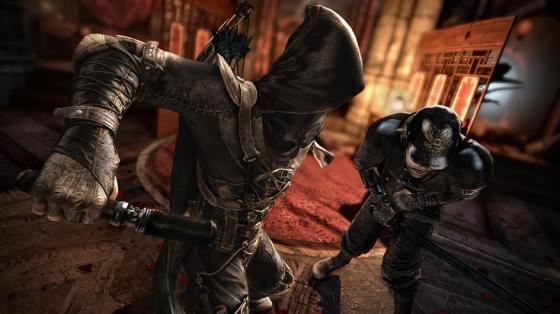
Much of Thief takes place within the walls of a pseudo-medieval city run by a tyrannical leader, Baron Northcrest, whose iron rule is making the rich richer and the poor poorer. After using military strength to secure his position, his uncaring and brutal rule is fostering growing unrest among a population ravaged by plague. Initially the plot seemed uncannily similar to Dishonored, but the maturity and complexity with which Thief handled comparable themes appeared to be more subtle.
Our presentation of the game involved Garrett infiltrating Baron Northcrest’s mansion with the intention of stealing a priceless gem called the Heart of the Lion. However, the growing civil unrest within the city has increased the numbers of guards on patrol, making the thief’s task much more difficult. Thief is played from a first-person perspective with a relatively minimal amount of information displayed on-screen. A single meter tucked into the bottom left corner indicated Garrett’s health, “Focus” (more on that later) and how visible he is to other characters.
Commenting on the nominal heads-up display, the developers explained they wanted to increase the level of immersion and provide feedback to the player in more subtle ways. While a small circular “moon” lights up when Garrett is visible, the edges of the screen become darker when he is hidden alongside the moon fading to grey. Equally, menu screens and Garrett’s inventory are kept simple, maximising information and reducing time spent out of the game.
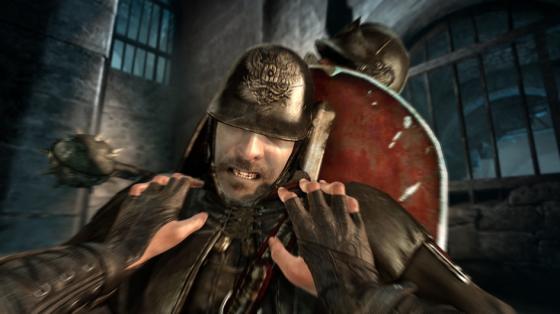
Eidos Montreal emphasised that Thief is a game that is designed to be played stealthily, with non-lethal and non-detection runs being encouraged. While it is possible to be less than subtle, fighting with enemies and killing opponents, this approach will be met with fewer rewards. For the purposes of the demonstration, the developers employed a mixture of strategies to highlight the options at Garrett’s disposal. Moving from his initial hiding spot, atop a gothic stone column, the master thief dropped into the grounds of Northcrest Manor and began his infiltration.
Garrett is particularly nimble and his movement seemed more fluid and mobile than other comparable stealth games. The thief has access to a quick dash combined with a duck that can be used to cover small gaps rapidly, and most importantly, stealthily. As he worked his way through the manicured hedges and ornate water features of the gardens, Garrett stuck to the grass which muffled his footfalls. He was able to interact with his environment in a number of ways, including turning off a water fountain which distracted guards and also opened up a new means of infiltrating the manor via the sewers.
The developers were keen to stress the variety of different options at players’ disposal, something they have taken on board from their work on Deus Ex: Human Revolution. Not only are there multiple ways to tackle missions (pure stealth, non-lethal stealth, lethal stealth, full combat and a mixture of the above) there are many different paths to, and from, your objective(s). Alongside primary goals, there are a range of optional side missions that provide extra benefits. In the gardens, Garrett was presented with the opportunity to pickpocket the Captain of the Guard in order to send an extra message to the Baron. However, the developers chose not to in order to pursue another means of entering the mansion.

Returning from previous Thief games were a plethora of different arrows. We spotted Rope, Moss and Blunt variants but Garrett initially used Water arrows to extinguish several torches. This had a twofold effect; plunging several areas into darkness and funnelling guards towards the distraction, both of which gave the thief ample opportunity to slip past. However, reaching a basement entrance, Garrett’s preferred access point to the manor, he was met with a trio of guards. Carefully observing their patrols showed there was no easy way past, forcing him to use one of his special tricks to gain entry.
One of Garrett’s abilities is “Focus”, an ability gained from an important event that occurs early on in the story. The developers were particularly coy about what this may be, but it suggests that some of the more supernatural elements from the previous titles may be returning. Focus has a twofold effect, slowing down time and increasing Garrett’s movement speed, and is measured via a small bar. In order to replenish Focus, poppies can be picked or found within levels that restore varying amounts. It is hardly a unique or original gameplay mechanic, but opened up a wealth of strategies.
Moving silently into position, Garrett crept close to one of the three guards while still maintaining a direct line of sight to the other two. Equipping an empty bottle from his inventory, he activated Focus, took aim and threw it towards one of the guards. As time was still slowed he equipped his bow and fired an arrow into the neck of the other distant enemy. As his Focus began to wear off he stepped forward, towards the guard he had manoeuvred close to, and promptly incapacitated him with a chokehold. In only a few seconds, Garrett had managed to eliminate the opposition. It was a neat demonstration and highlighted the range of different tactics that can be employed in order to achieve your objectives.
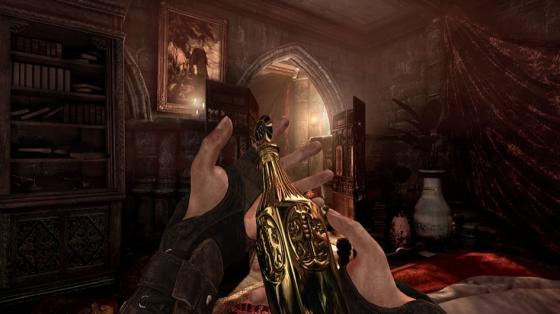
Arriving at a locked cellar entrance, it was necessary for Garrett to break in using a lockpick. Using a combination of visual clues, audio feedback and vibrations (with a gamepad), Garrett is able to pick the lock, although this can leave him completely vulnerable to detection from guards. Employing Focus allows him to see inside the lock, in a mini-game similar to The Elder Scrolls IV: Oblivion, speeding up the process. Entering the basement, Garrett rifled through a number of boxes, pilfering all sorts of petty valuables. However, his infiltration was not without dangers and he had to disarm a number of tripwire alarms and basic security systems. Here Focus proved useful, allowing the thief to scan his environment and pick out potential sources of detection that were highlighted with a pale blue glow.
Ascending a small flight of stairs, Garrett found himself in the lower floors of the building. Looking through keyholes and using Focus to detect guards’ footsteps allowed him to avoid detection and pickpocket gold from everyone he encountered. Successfully performing a stealth action, such as pick-pocketing, knocking enemies out or not triggering alarms awarded experience points. However, these were not explained and the developers seemed keen to keep them under wraps for the time being.
Occasionally, Garrett would find himself facing a guard that was difficult to evade, prompting him to employ a takedown. Entering into a library the thief used a rope arrow to ascend on top of the bookcases and creep into position above an unsuspecting enemy. Dropping from above prompted a third-person animation showing Garrett bludgeoning the guard into unconsciousness with his trusty blackjack, a nice throwback to the original titles. It was not made clear whether bodies could then be moved, but hopefully this will be an option.
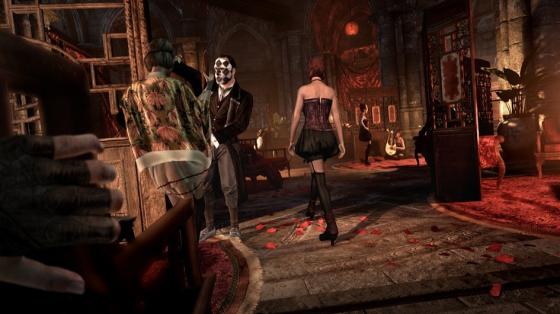
While exploring the library, Garrett stumbled across a map, drawn in the same style as the original games. Collecting these can reveal important clues to mission goals and also provide an optional mini-map. Scanning the blueprints revealed the location of a hidden room, the likely location of the Heart of the Lion. As Garrett left the library, the door animations seemed slow and clunky which hopefully won’t make their way into the final game. Movement and speed are so important in stealth-based titles, that having such protracted and sluggish animations could cause potential frustration.
Moving silently into a corridor, Garrett began searching for any sign of the hidden room. Opening a locked cupboard revealed a shaft of light shining from a tiny hole in a wall. Peeping through the crack revealed an ornate locked chest, with no clear way of access into the chamber. Slipping back into the corridor, after checking the coast was clear; Garrett began searching each of the pictures in the corridor for a secret button. Sure enough, after sliding his fingers around the edges of several he stumbled across the switch opening up a door to the room.
Inside was a rudimentary puzzle, requiring the use of rotating weights to activate two locks. Upon completion the Heart of the Lion rose from the chest. It was an interesting break from the tense stealth combat and required the use of Focus alongside more traditional clues. Once Garrett had the gem, he used a Rope Arrow to escape the room via a skylight. At this point, Eidos Montreal faded the demonstration out and cut forward to a slightly later stage to minimise plot details.
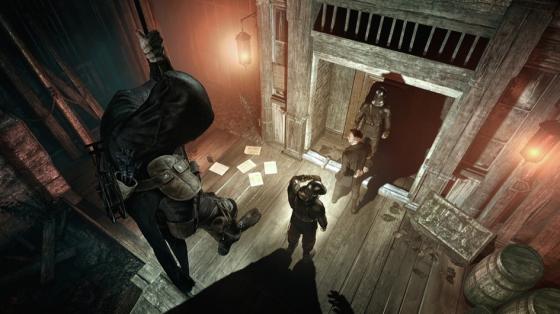
Garrett still appeared to be in possession of the Heart of the Lion but it appeared the angry mob hinted at during the opening of the mission had begun to burn parts of the city to the ground. Fleeing for his life, the thief was forced to escape across a burning “Aldale Bridge” avoiding the rising flames and pursuing enemies. What followed was a particularly intense sequence involving careful movement, puzzle solving and a limited selection of quick-time events.
At various intervals button combinations and prompts would flash on screen, usually in order to prevent Garrett from falling off a ledge. While they did not appear to be too intrusive they felt rather out of place in an otherwise immersive environment. Elsewhere, Garrett had to dodge burning timber falling from above, carefully worm his way through narrow gaps avoiding the flames and turn off gas valves that prevented his progress.
The set piece culminated in a daring sprint across the burning, collapsing roof of the bridge in order to get to safety. Subtle on-screen prompts gave indicators in which directions Garrett should move and the whole sequence felt intense, exhilarating and epic in scale. Reaching a final jump, the thief managed to make a daring leap to security which brought up a mission statistics screen. Before it was swiftly closed down by the developers we caught sight of categories including how many kills and knockouts were scored as well as how much gold Garrett had stolen.
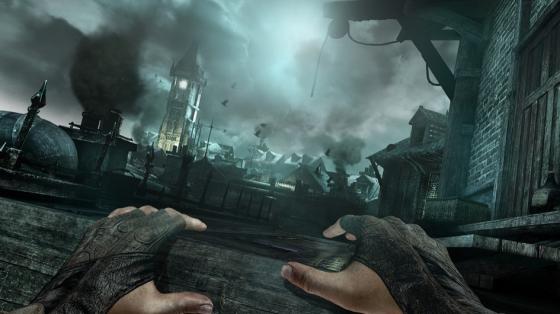
We were very pleasantly surprised with Thief, especially for a game that has been in development for such a long time. The atmosphere felt dark, mysterious and compelling from the very beginning. We really felt that Thief has the gameplay to match, always a bold statement when referring to a hands-off demonstration. Yet, the variability and wealth of options, familiar from Deus Ex, really shone through at dozens of times during the presentation. Indeed, the developers were even caught out by the AI and had to react on the spot with alternative strategies.
Thief is definitely displaying a huge amount of potential and we sincerely hope that the narrative is as strong and twisting as past instalments. Equally, comparisons to Dishonored will no doubt be numerous, but Thief is clearly a different beast in style and, seemingly, substance. We cannot wait to see more from the game, especially after such strong showings at E3 and gamescom. In the meantime, Eidos Montreal will be tweaking and polishing over the coming months in preparation for a release on PC, PlayStation 3, PlayStation 4, Xbox 360 and Xbox One in February next year.




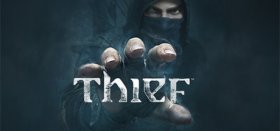







COMMENTS